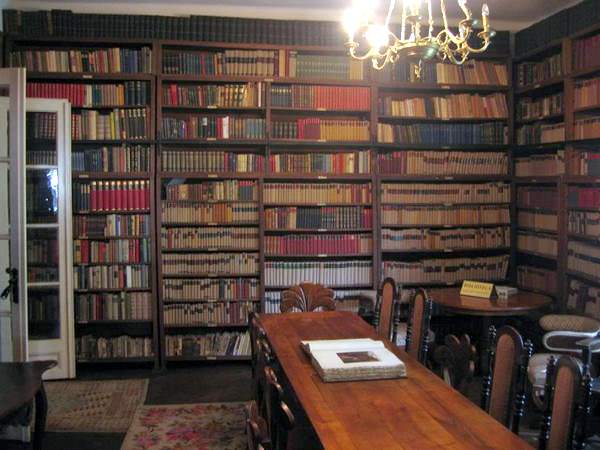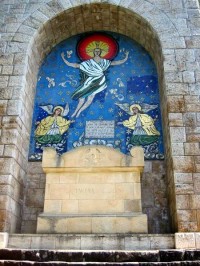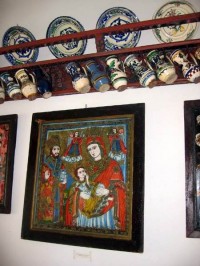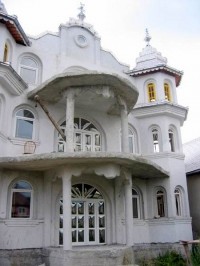The area of Romania known as Calata (in Romanian) or Kalotaszeg (in Hungarian) may be rich in traditions, but it also has some unexpected sides. In among the sleepy Transylvanian villages and farms, the well-preserved medieval churches, and the peasant handicrafts, there are a few unusual things that stand out.
 For one, there is the castle in the village of Stana (Sztana in Hungarian) that was built in 1910 by Karoly Kos, a Hungarian architect. Called the Varjuvar, or “crow castle,” it served as his home and workshop for a good portion of his life. Kos was a student of the area’s folk architecture, and he incorporated elements of it into his own creations. But for all the traditional features of its construction, the building definitely has the feel of having been created in the modern era, and by a highly individual, waywardly talented person.
For one, there is the castle in the village of Stana (Sztana in Hungarian) that was built in 1910 by Karoly Kos, a Hungarian architect. Called the Varjuvar, or “crow castle,” it served as his home and workshop for a good portion of his life. Kos was a student of the area’s folk architecture, and he incorporated elements of it into his own creations. But for all the traditional features of its construction, the building definitely has the feel of having been created in the modern era, and by a highly individual, waywardly talented person.
 Other people answering that description were among the residents of a notable architectural complex in Ciucea (Csucsa). This complex, atop a promontory at the east edge of the town, was the home of the writer Octavian Goga. It includes a palace with yellow outer walls where Goga himself resided. You can visit his pretty library with 6,000 volumes (he could read in six languages) and the bedroom where he died.
Other people answering that description were among the residents of a notable architectural complex in Ciucea (Csucsa). This complex, atop a promontory at the east edge of the town, was the home of the writer Octavian Goga. It includes a palace with yellow outer walls where Goga himself resided. You can visit his pretty library with 6,000 volumes (he could read in six languages) and the bedroom where he died.
 Also on the grounds is a white-colored house, which contains displays of Transylvanian furniture, folk costumes and icons. These items, dating from the 17th to 19th centuries, were collected by Goga. The house, for a while, was the home of the writer Endre Ady with whom Goga had what must be described as a most unlikely friendship. The Hungarian Ady wrote symbolist, erotic poetry, lived hedonistically and criticized rural life compared to his own urban existence, while Goga, a patriotic Romanian, celebrated the charm of villages.
Also on the grounds is a white-colored house, which contains displays of Transylvanian furniture, folk costumes and icons. These items, dating from the 17th to 19th centuries, were collected by Goga. The house, for a while, was the home of the writer Endre Ady with whom Goga had what must be described as a most unlikely friendship. The Hungarian Ady wrote symbolist, erotic poetry, lived hedonistically and criticized rural life compared to his own urban existence, while Goga, a patriotic Romanian, celebrated the charm of villages.
Another interesting feature here is the mausoleum where Goga and his wife, Veturia, lie side-by-side. Veturia, a visual artist, created the colorful mosaic work that covers the mausoleum – it took her 20 years.
 The grounds also contain a little stone church, where services are still sometimes held. Constructed in 1575 in a nearby village, the church was transferred here, stone-by-stone, on the instructions of Veturia Goga, to spare it from destruction. The church is quite tiny inside – watch your head! The whole Ciucea complex can be visited from Tuesday to Sunday between 10am and 5pm. Incidentally, Ciucea also happens to be a good place to bathe in the Cris river, as it runs quite shallow here and the water is warm in summer.
The grounds also contain a little stone church, where services are still sometimes held. Constructed in 1575 in a nearby village, the church was transferred here, stone-by-stone, on the instructions of Veturia Goga, to spare it from destruction. The church is quite tiny inside – watch your head! The whole Ciucea complex can be visited from Tuesday to Sunday between 10am and 5pm. Incidentally, Ciucea also happens to be a good place to bathe in the Cris river, as it runs quite shallow here and the water is warm in summer.
Belis (Josikafalva) is a village with a haunting story to tell. Its inhabitants were  forced to move from the original, low-lying location to the top of a hill in the early 70s when the communist government decided to create an artificial lake here. The old village church still stands under the lake, although the local folk did take its furniture and icons with them and even exhumed their dead to rebury them in the new site. The church is still clearly visible to the many tourists who row boats across the lake or scuba-dive under its surface. In hot weather, the cross atop the church tower appears above the water’s surface. It is said that under the church is a fortune. Belis today is a very nice, relaxing resort town with a host of tourism, sport and spa facilities. The surrounding hills are also good for hiking, strolling, and skiing.
forced to move from the original, low-lying location to the top of a hill in the early 70s when the communist government decided to create an artificial lake here. The old village church still stands under the lake, although the local folk did take its furniture and icons with them and even exhumed their dead to rebury them in the new site. The church is still clearly visible to the many tourists who row boats across the lake or scuba-dive under its surface. In hot weather, the cross atop the church tower appears above the water’s surface. It is said that under the church is a fortune. Belis today is a very nice, relaxing resort town with a host of tourism, sport and spa facilities. The surrounding hills are also good for hiking, strolling, and skiing.
 The main town in the region, Huedin, is a great place to see an architectural phenomenon that has become quite prevalent in Transylvania over the past ten or fifteen years. These are the showy mansions built by people of the Roma (Gypsy) ethnicity. This group has increased in size in Huedin since the fall of communism, and several families have become wealthy (at least by local standards), thanks to money sent home by young relatives who work in western countries. They have poured the cash into big houses topped with glittering roofs made of steel galvanized with zinc. Occasionally the roofs are adorned by shiny insignia such as western automobile logos or currency symbols.
The main town in the region, Huedin, is a great place to see an architectural phenomenon that has become quite prevalent in Transylvania over the past ten or fifteen years. These are the showy mansions built by people of the Roma (Gypsy) ethnicity. This group has increased in size in Huedin since the fall of communism, and several families have become wealthy (at least by local standards), thanks to money sent home by young relatives who work in western countries. They have poured the cash into big houses topped with glittering roofs made of steel galvanized with zinc. Occasionally the roofs are adorned by shiny insignia such as western automobile logos or currency symbols.
Finally, a head-scratcher. Calata/Kalotaszeg is known as an area populated by Hungarian-speakers, and as a stronghold of ancient customs of that ethnicity. But Calata also happens to be the name of one particular village in the area, and it’s a highly unusual one: its residents are Romanians.
Written By David Hill for EuropeUpClose
